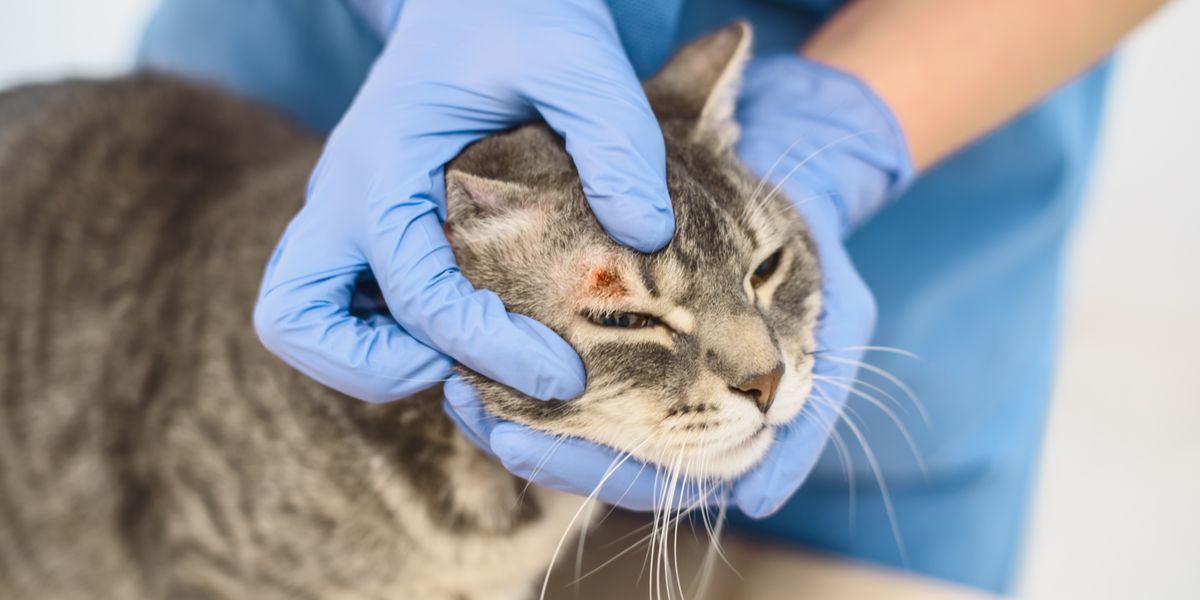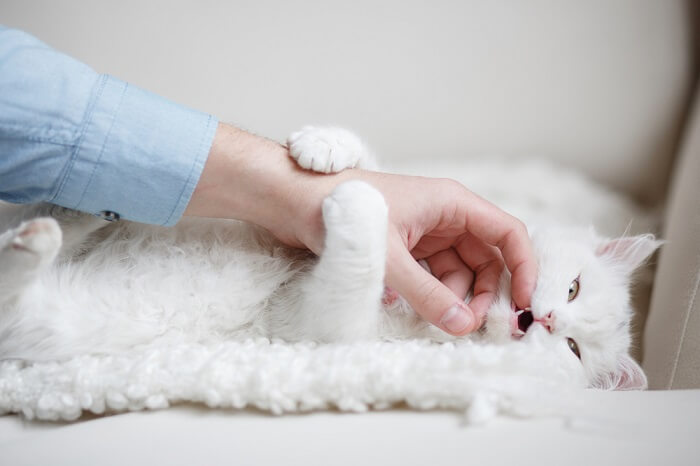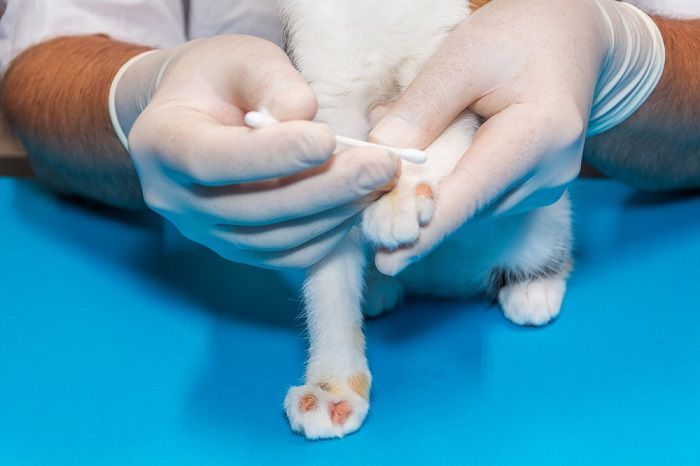
The aim of this article is to provide a simple, clear explanation about ringworm for cat owners. This is a common skin disease in cats, with a particular significance in that it is a zoonotic disease (humans can pick up the infection).
What Is Ringworm?
Ringworm (also known as dermatophytosis) is the name given to a fungal infection of the skin, hair and nails, which classically causes circular areas of baldness and other changes to the skin, hair and nails. There is no “worm” involved: it’s caused by a fungus.
Ringworm infection may be caused by a number of different fungal organisms, known as dermatophytes.
The most common dermatophytes in cats include:
- Microsporum canis: Usually following contact with another infected cat
- Trichophyton mentagrophytes: Typically following contact with rodents
- Microsporum persicolor: Seen more rarely, mostly following contact with voles
- Trichophyton erinacei: Also seen rarely, following contact with hedgehogs
How Common Is Ringworm?
Ringworm infection is a common problem, especially in kittens and younger cats. Older cats tend to be immune following exposure earlier in life, so they are less commonly affected. Older cats that have immune system issues may be more likely to pick up ringworm.
How Do Cats Get Ringworm?
Cats pick up ringworm following direct contact with ringworm (fungal) spores, either by physical contact with an infected animal, or by physical contact with an inanimate object, such as furniture, bedding, food bowls, brushes and combs.
After the spores have settled in the skin, they germinate, producing fungal hyphae (like stems of an ivy-like plant) that grow outward and inward, invading skin and nail surfaces (keratin) and establishing the infection.
How Do Humans Get Ringworm?
Pet owners should be aware that ringworm is a zoonosis—humans can pick up ringworm from their pets. Ringworm lesions in humans are generally circular, reddened areas of skin, seen especially in areas where the person may have physically been in contact with the cat (for instance, the forearms, hands, and neck).
Children and young people are more prone to picking up ringworm; previous exposure tends to lead to some level of immunity in older people. If a human is affected, they should contact their medical doctor.
To avoid human infections of ringworm, take care when handling a cat that may have ringworm. Affected cats should be separated from children in particular.
Symptoms of Ringworm in Cats
Clinical signs associated with ringworm are areas of hair loss (alopecia), as well as crusty, scabby areas, increased skin scales (like dandruff) and a variable level of inflammation (a form of dermatitis, with redness, soreness and itchiness).
Sometimes, distinct focal patches of alopecia are seen (the classic bald area 1 to 2 centimeters in diameter). Other times, the cat may have a wide area of alopecia (e.g., a bald head) or patchy alopecia all over (a moth-eaten appearance).
Diagnosis of Ringworm

If your veterinarian suspects that your cat may have ringworm, the following steps may be taken.
1. Detailed History Taking
Your vet will discuss every aspect of your cat’s life and health care. There are other causes of the same types of signs as ringworm, and this history will help to differentiate the various possible causes.
2. Physical Examination
Your veterinarian will check your cat over carefully, noting any physical signs of illness, ruling out other causes of the signs that are being shown (e.g. fleas, lice, other parasites).
3. Wood’s Lamp Screening
Your veterinarian may use an ultraviolet light (called a Wood’s lamp) to view your cat’s skin and the affected areas. Some strains of Microsporum canis produce metabolic byproducts that fluoresce (glow) an apple-green color. A negative result with this test does not rule out ringworm, as not all cases are positive.
4. Microscopic Examination of Hairs and Skin Debris
Your veterinarian may collect samples of hair and debris from around infected areas of skin and examine them under the microscope to check for fungal spores or hyphae.
If fluorescence is seen with the ultraviolet light, the veterinarian may collect some of the infected hairs or other skin debris that light up as they are more likely to be positive under the microscope.
5. Fungal Culture
Fungal culture is the only definitive way to confirm a diagnosis of ringworm. Hairs may be plucked with gloved fingers or forceps, or a sample may be collected using a toothbrush method (brushing the affected area first, then applying the toothbrush bristles to the fungal growth medium).
Sometimes, your veterinarian may use an in-house fungal culture (called Sabouraud’s medium, or a proprietary equivalent); other times, your veterinarian may submit the sample to an external laboratory for culture, which tends to be a more accurate way of specifically identifying the precise dermatophyte causing the infection.
6. PCR Testing
Polymerase chain reaction (PCR) testing is the latest method that may be recommended to check for ringworm. Fungal culture requires at least 14 days for a final result, compared with one to three days for PCR.
7. Skin Biopsy
If other tests are negative, the ultimate way to investigate the cause of skin lesions is to take a full biopsy for detailed examination under the microscope by an experienced professional pathologist.
This is not always necessary, but in rare cases that test negative using other methods, it’s sometimes carried out. In some cases, a biopsy may be taken to check for other skin diseases, and ringworm skin infection may be identified unexpectedly.
Treatment for Ringworm

Treatment for ringworm often includes topical medication plus oral medications and treatment of the home.
Ringworm is ideally treated with a combination of topical and systemic therapy (oral medications) for the cat, combined with treatment of the environment. If a multiple cat household has an outbreak of ringworm, all of the cats in the house may need to be treated, even if they have no signs of ringworm.
Topical Therapy for the Cat
Topical treatment means direct application of medication to the cat’s skin and fur. Examples include antifungal shampoos, lotions and ointments, using ingredients such as miconazole, chlorhexidine, terbinafine, clotrimazole or enilconazole.
Sometimes the cat’s fur is clipped off to remove repeated contamination of the skin from fungal spores attached to the hairs. This is more likely to be necessary in longhaired cats.
Systemic Therapy for the Cat
A number of different oral medications may be given to the cat to treat ringworm systemically (i.e., from the inside out). Examples include:
- Griseofulvin: This was the traditional treatment and it was highly effective, but its availability is now very limited in many countries. Side effects of griseofulvin include adverse effects on unborn kittens (and human babies if pregnant women are exposed to the medication), and this is one of the reasons why the product has fallen out of use.
- Itraconazole: This is now the only licensed antifungal medication for ringworm in the UK and some other countries. It is formulated as a liquid that is given once daily for a week. It is then withheld for a week, then followed by another week of treatment. This regime continues, so that treatment is given on weeks one, three and five, but not on weeks two and four.
Treatment of the Environment

Ringworm can sometimes cause all-over hair loss that gives the cat a moth-eaten appearance.
Treatment of the cat’s environment is also necessary by vacuuming living areas (burning the vacuum cleaner bag afterwards), and using bleach or another disinfectant to wipe down hard surfaces such as flooring.
This is important to prevent other animals or humans from picking up infection, as well as being necessary to avoid reinfection of the treated cat.
How Much Does It Cost To Treat a Cat With Ringworm?
It is impossible to estimate the cost of treating cases of ringworm as there are many possible factors going on in the background of individual cases. You should ask your veterinarian for a detailed estimate before agreeing to proceed with treatment. If a multiple cat household is infected, all of the cats may need to be treated, which can significantly add to treatment costs.
In general, topical treatment is inexpensive, while oral systemic medication such as itraconazole can be costly. However, oral medication is very important to achieve a timely and effective cure.
Monitoring and Prognosis
Repeated sampling and culture of cats’ skin and fur may be advised to ensure that a full cure has been achieved.
Conclusion
Ringworm is a common skin infection of cats, especially in kittens, and it can be passed on to humans, so it needs to be taken especially seriously.







